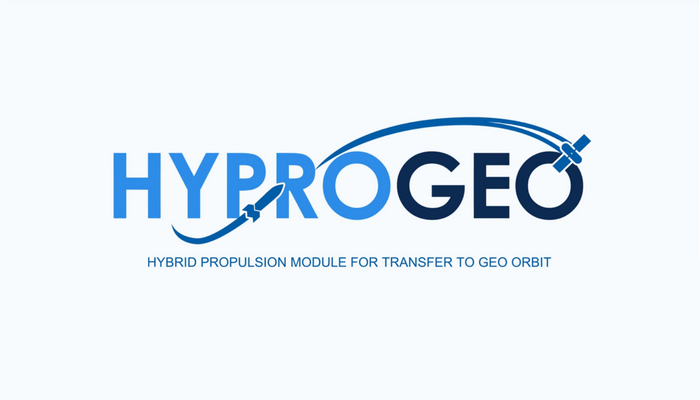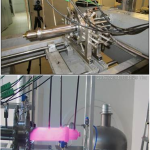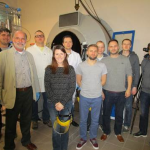At the end of January 2018, the Institute of Aviation successfully completed tasks under the European project “Hybrid Propulsion System for LEO, MEO and GEO transfer” (HYPROGEO) co-financed by the European Commission under the Horizon 2020 programme. The main aim of the project was to develop a satellite propulsion module based on a hybrid rocket engine that uses 98% hydrogen peroxide as the oxidizer. Within the project a laboratory-scale demonstrator of a hybrid engine with a circumferential injection of decomposition products of catalytically decomposed 98% HTP was developed and tested. Additionally, a new PX-1 catalyst, developed by AIRBUS UK, was tested for operations with 98% hydrogen peroxide.
The main goals for the Institute of Aviation were to design and manufacture of pressurized feed system and to perform qualification tests with Small Scale Decomposition Chamber using PX-1 catalyst, prepared and delivered to the Institute of Aviation by AIRBUS UK. The qualification tests concerned long duration (up to 600 sec) tests with 98% hydrogen peroxide, prepared and delivered to the Institute of Aviation by EVONIK. The obtained results have shown that PX-1 catalyst withstand thermal shocks and long exposition on highly concentrated (98%) hydrogen peroxide.
The ambition of the HYPROGEO project, which was co-funded by the European Commission under the Horizon 2020 programme, was to develop a propulsion engine based on hybrid chemical propulsion. Hybrid propulsion is not a new technology but its application to a transfer module or to a re-ignitable upper stage is very innovative. It is an interesting alternative for the GEO transfer, which is currently limited to two options: either to rely on chemical (liquid) propulsion or on the newly developed Electrical Propulsion (EP) technology. Hybrid propulsion features very good synergies and complementarities with those solutions as its thrust level lies between what they are capable of. Moreover, it presents two benefits: green and simpler design (compared to bi-liquid), shorter transfer time and reduced cost of operations (compared to electric propulsion).
A TRL 4 (for the combustion chamber, catalytic injector, and high concentration hydrogen peroxide) to 5 (for the full engine and the nozzle) is expected at the end of the project.
The impact of the project was ensured by a consortium of European actors of hybrid propulsion technologies led by Airbus Defence & Space. The team contributes thus to the consolidation of the European industrial supply chain for hybrid propulsion. The consortium embodies a true European dimension, with 12 partners from 7 countries: Belgium, France, Germany, Italy, Norway, Poland, and United Kingdom.
The project kicked off in February 2015 for a duration of 36 months.
The tasks for the HYPROGEO project was carried out at the Space Technologies Department at the Institute of Aviation.
Official website: https://www.hyprogeo.eu/news















